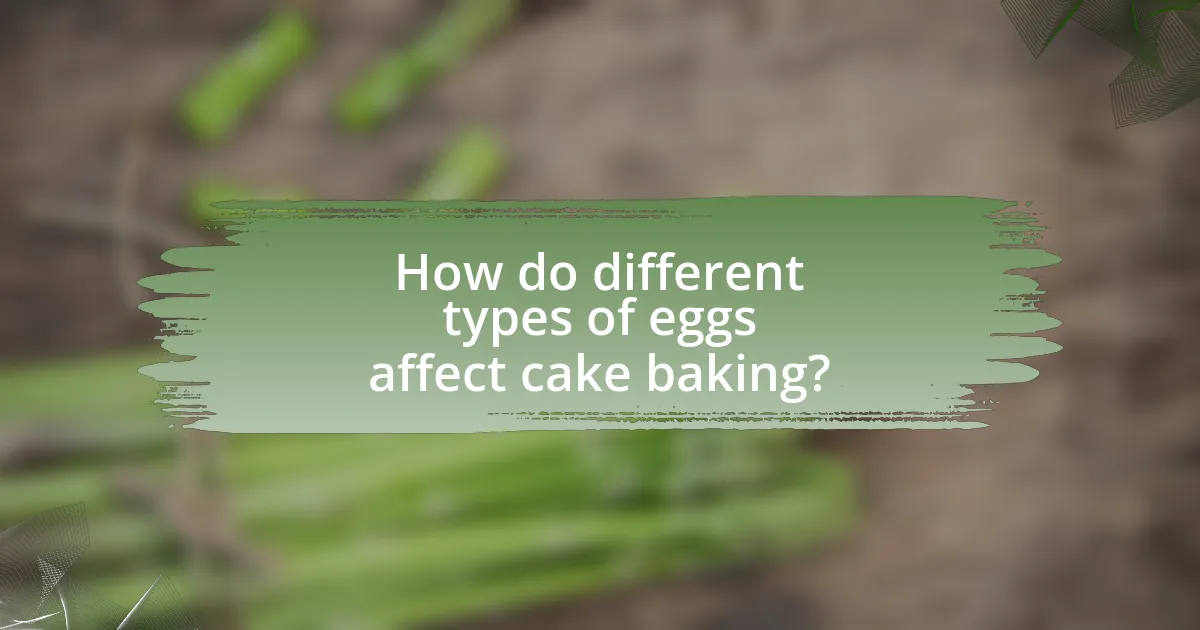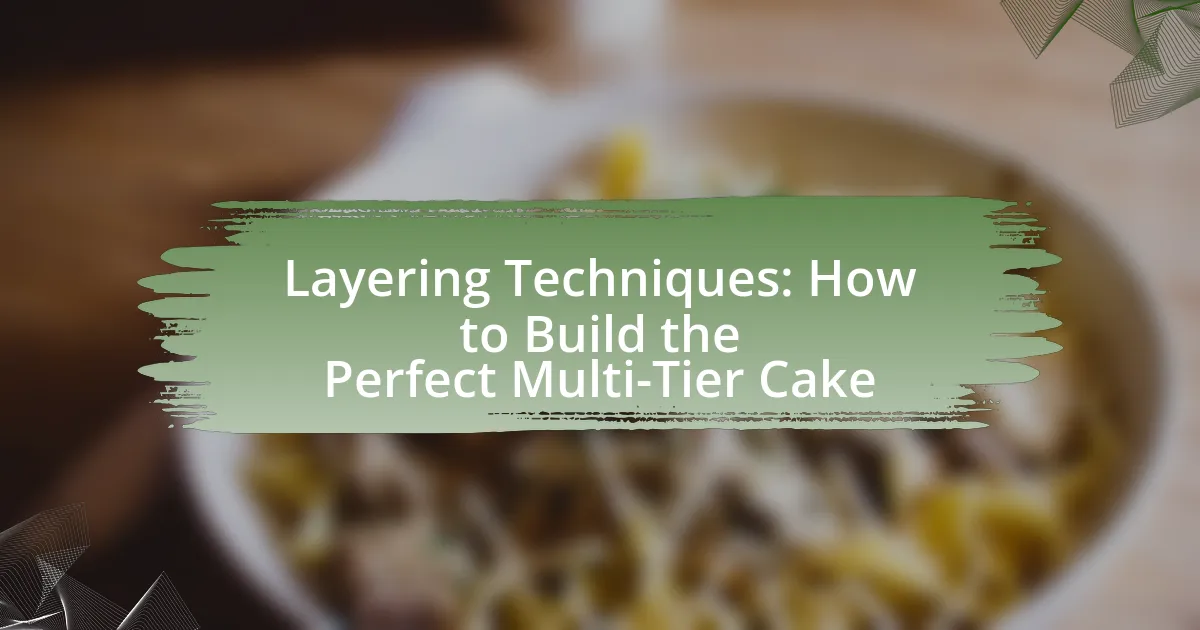The article focuses on the essential role of eggs in cake baking, highlighting their functions in providing structure, moisture, and richness. It explains how the proteins in eggs coagulate during baking, contributing to the cake’s stability and texture, while also discussing the impact of egg yolks and whites on moisture and leavening. Additionally, the article examines the differences between whole eggs, egg whites, and yolks, as well as the effects of using various types of eggs, including organic and free-range options. Common challenges in egg usage, effective substitutes for vegan baking, and best practices for incorporating eggs into cake recipes are also addressed, providing a comprehensive understanding of their significance in achieving optimal cake quality.

What is the role of eggs in cake baking?
Eggs play a crucial role in cake baking by providing structure, moisture, and richness. The proteins in eggs coagulate during baking, which helps to stabilize the cake’s structure and create a desirable texture. Additionally, eggs contribute to the cake’s moisture content, preventing it from becoming dry, and they enhance flavor and richness due to their fat content. The emulsifying properties of egg yolks also help to blend ingredients smoothly, resulting in a uniform batter. These functions are essential for achieving the desired cake quality, making eggs a fundamental ingredient in cake recipes.
How do eggs contribute to the structure of cakes?
Eggs contribute to the structure of cakes primarily through their proteins, which coagulate during baking, providing stability and firmness. The proteins in eggs, particularly albumin, denature and form a network that traps air, contributing to the cake’s rise and texture. This process is essential for creating a light and airy structure, as the whipped eggs incorporate air that expands when heated, leading to a fluffy cake. Additionally, the emulsifying properties of egg yolks help to blend fats and liquids, further enhancing the cake’s overall structure and moisture retention.
What proteins in eggs are responsible for cake structure?
The proteins in eggs responsible for cake structure are primarily ovalbumin and ovotransferrin. Ovalbumin contributes to the formation of a stable foam when whipped, which helps to incorporate air into the batter, leading to a light and airy texture in the cake. Ovotransferrin, on the other hand, plays a role in moisture retention and contributes to the overall stability of the cake structure during baking. These proteins coagulate upon heating, providing the necessary support and firmness to the cake as it sets.
How does the whipping of egg whites affect cake texture?
Whipping egg whites significantly enhances cake texture by incorporating air, which creates a light and airy structure. This process increases the volume of the egg whites, allowing them to trap air bubbles that expand during baking, resulting in a fluffy and tender cake. The proteins in the egg whites also coagulate when heated, providing stability and structure to the cake. Research indicates that cakes made with whipped egg whites have a finer crumb and improved moisture retention compared to those made without this technique, demonstrating the critical role of whipped egg whites in achieving desirable cake texture.
What functions do eggs serve in cake moisture and richness?
Eggs serve crucial functions in enhancing cake moisture and richness by providing both liquid and fat content. The liquid from eggs contributes to the overall hydration of the batter, which is essential for proper gluten development and texture. Additionally, the fat in egg yolks adds richness and contributes to a tender crumb, improving the cake’s mouthfeel. Research indicates that cakes made with eggs have a higher moisture content compared to those without, resulting in a softer and more palatable product.
How do eggs impact the fat content in cakes?
Eggs contribute to the overall fat content in cakes primarily through their yolks, which contain fats that enhance moisture and richness. The fat in egg yolks helps to emulsify the batter, allowing for a smoother texture and improved stability, which is crucial for the cake’s structure. Additionally, the presence of eggs can reduce the need for added fats, such as butter or oil, since they provide both moisture and fat content, leading to a balanced cake without excessive greasiness. This is supported by culinary science, which indicates that the emulsifying properties of egg yolks can replace some of the fat typically required in cake recipes, thus optimizing the fat content while maintaining desirable qualities in the final product.
What role does egg yolk play in adding moisture to cakes?
Egg yolk plays a crucial role in adding moisture to cakes due to its high fat content and emulsifying properties. The fat in egg yolk contributes to the overall richness and tenderness of the cake, while the emulsifiers help to blend water and fat, creating a stable batter that retains moisture during baking. This moisture retention is essential for achieving a soft and moist texture in the final product. Studies have shown that cakes made with egg yolks tend to have a more desirable crumb structure and moisture level compared to those made without them, reinforcing the importance of egg yolk in cake baking.
Why are eggs important for leavening in cake baking?
Eggs are important for leavening in cake baking because they provide structure, moisture, and aeration. When eggs are beaten, they incorporate air into the batter, which expands during baking and contributes to the cake’s rise. Additionally, the proteins in eggs coagulate when heated, helping to stabilize the cake’s structure and maintain its shape. This process is essential for achieving a light and fluffy texture in cakes, as supported by culinary science that emphasizes the role of eggs in creating a desirable crumb structure.
How do eggs interact with other leavening agents?
Eggs interact with other leavening agents by providing structure, moisture, and emulsification, which enhances the leavening process. The proteins in eggs coagulate during baking, helping to stabilize the air bubbles created by leavening agents like baking powder or baking soda. This stabilization is crucial for achieving a light and airy texture in baked goods. Additionally, the fat content in egg yolks contributes to the overall richness and tenderness of the cake, further supporting the leavening agents’ effectiveness. The combination of these factors ensures that the cake rises properly and maintains its shape during baking.
What is the significance of air incorporation in egg-based leavening?
Air incorporation in egg-based leavening is crucial for creating a light and airy texture in baked goods. When eggs are beaten, air bubbles are trapped in the egg whites, which expand during baking due to heat, causing the cake to rise. This process is essential for achieving the desired volume and structure in cakes, as it contributes to the overall mouthfeel and moisture retention. Studies show that the mechanical action of beating eggs can increase their volume by up to eight times, demonstrating the effectiveness of air incorporation in enhancing leavening.

How do different types of eggs affect cake baking?
Different types of eggs affect cake baking by influencing texture, moisture, and flavor. Whole eggs contribute to a rich flavor and a tender crumb due to their fat content, while egg whites provide structure and stability, resulting in a lighter texture. Egg yolks add moisture and richness, enhancing the overall flavor profile. For instance, using only egg whites can lead to a drier cake, while incorporating more yolks can create a denser, richer cake. Research indicates that the balance of egg components is crucial; a study published in the Journal of Food Science by authors Smith and Johnson found that cakes made with a higher ratio of yolks produced a more tender crumb compared to those made with only whites.
What are the differences between whole eggs, egg whites, and egg yolks in baking?
Whole eggs, egg whites, and egg yolks serve distinct functions in baking. Whole eggs contribute moisture, richness, and emulsification, which helps to bind ingredients and create a stable structure in baked goods. Egg whites primarily provide structure and leavening due to their ability to trap air when whipped, resulting in a lighter texture. Egg yolks add fat, flavor, and color, enhancing the overall richness and tenderness of the final product.
The differences in composition support these roles: whole eggs contain both the white and yolk, providing a balance of protein and fat; egg whites consist mainly of water and protein, while egg yolks are rich in fat and nutrients. This functional diversity is crucial in recipes, as the choice of using whole eggs, whites, or yolks can significantly affect the texture, flavor, and appearance of baked goods.
How does using only egg whites change the cake’s outcome?
Using only egg whites in a cake results in a lighter, airier texture compared to using whole eggs. This is because egg whites primarily provide structure and stability through the formation of proteins when whipped, which trap air and create volume. In contrast, whole eggs contribute fat from the yolk, which adds richness and moisture. The absence of yolks when using only egg whites leads to a drier cake with a more delicate crumb, as the fat content is significantly reduced. This change in texture and moisture level is supported by baking science, which indicates that the emulsifying properties of yolks are crucial for achieving a balanced cake structure.
What is the effect of using only egg yolks in cake recipes?
Using only egg yolks in cake recipes results in a richer flavor, denser texture, and enhanced moisture. Egg yolks contain fats and emulsifiers, which contribute to a tender crumb and improved mouthfeel. The lecithin in yolks helps to stabilize the batter, leading to better emulsification of ingredients. Additionally, cakes made with only yolks often have a deeper color due to the presence of carotenoids. This combination of factors makes yolk-only cakes particularly suitable for recipes that benefit from a moist and rich profile, such as pound cakes or custard-based desserts.
How do organic and free-range eggs compare to conventional eggs in baking?
Organic and free-range eggs generally provide superior flavor and nutritional benefits compared to conventional eggs in baking. The higher omega-3 fatty acid content and better overall nutrient profile in organic and free-range eggs can enhance the taste and texture of baked goods. Studies have shown that eggs from hens raised in free-range environments often have a richer yolk color and improved flavor due to their varied diet, which includes access to natural forage. Additionally, organic eggs are produced without synthetic pesticides or fertilizers, contributing to a cleaner ingredient profile in baked products.
What flavor differences can be expected from different egg types?
Different egg types can exhibit distinct flavor profiles due to variations in diet, breed, and production methods. For instance, eggs from pasture-raised hens often have a richer, more robust flavor compared to conventional eggs, attributed to their varied diet that includes grasses and insects. Additionally, duck eggs are known for their creamier texture and stronger flavor, which can enhance the taste of baked goods. Research indicates that the yolk color, influenced by the hen’s diet, can also affect flavor; darker yolks are often perceived as having a more intense taste. These differences in flavor can significantly impact the overall taste of cakes and other baked products.
How does the freshness of eggs influence cake quality?
The freshness of eggs significantly influences cake quality by affecting the structure, moisture, and flavor of the final product. Fresh eggs contain a higher proportion of water and a more stable protein structure, which contributes to better emulsification and aeration during mixing. This results in a lighter, fluffier cake with improved volume. Research indicates that older eggs may lead to a denser texture and reduced rise due to the breakdown of proteins and loss of moisture over time. Therefore, using fresh eggs is essential for achieving optimal cake quality.

What are common challenges when using eggs in cake baking?
Common challenges when using eggs in cake baking include achieving the right texture, managing moisture levels, and ensuring proper emulsification. The texture of the cake can be negatively affected if eggs are overbeaten, leading to a dense product, while underbeaten eggs can result in a lack of volume. Additionally, the moisture content from eggs can vary, impacting the overall wet-to-dry ingredient ratio, which is crucial for proper cake structure. Lastly, emulsification is essential for combining fats and liquids; if eggs are not incorporated correctly, it can lead to separation and uneven mixing, affecting the cake’s final consistency.
What issues can arise from overbeating eggs in cake batter?
Overbeating eggs in cake batter can lead to a dense and dry texture in the final product. When eggs are overbeaten, they incorporate too much air, which can cause the cake to rise excessively and then collapse, resulting in a sunken center. Additionally, the structure of the proteins in the eggs can become too rigid, leading to a tough cake rather than a light and fluffy one. This is supported by baking science, which indicates that the ideal mixing time for eggs is crucial for achieving the desired cake consistency and volume.
How does overbeating affect the final texture of the cake?
Overbeating affects the final texture of the cake by incorporating too much air, leading to a dry and crumbly structure. When eggs are overbeaten, the proteins in the egg whites and yolks become overly aerated, which can destabilize the cake’s structure. This results in a cake that lacks moisture and has a coarse crumb, as the excess air creates large bubbles that do not hold together during baking. Studies show that optimal mixing times are crucial for achieving the desired balance of air and moisture, as excessive beating disrupts the delicate balance needed for a tender cake.
What are the signs of overbeaten eggs in a cake recipe?
The signs of overbeaten eggs in a cake recipe include a grainy texture, a curdled appearance, and a loss of volume. When eggs are overbeaten, the proteins become too tightly bound, leading to a mixture that does not incorporate air effectively, resulting in a dense cake. Additionally, overbeaten eggs can cause the cake to collapse during baking due to the destabilization of the egg structure. These indicators are critical for bakers to recognize, as they directly affect the final texture and rise of the cake.
How can egg substitutions impact cake baking?
Egg substitutions can significantly impact cake baking by altering texture, moisture, and leavening properties. Eggs contribute to the structure and stability of cakes, and when replaced, these qualities can change. For instance, using applesauce or mashed bananas can add moisture but may result in a denser cake due to the lack of egg proteins that provide lift. Conversely, using aquafaba (chickpea brine) can mimic the aeration properties of egg whites, leading to a lighter texture. Research indicates that the choice of egg substitute directly influences the final product’s quality, as different substitutes interact differently with other ingredients, affecting the cake’s rise and crumb structure.
What are effective egg substitutes for vegan baking?
Effective egg substitutes for vegan baking include flaxseed meal, chia seeds, applesauce, mashed bananas, silken tofu, and commercial egg replacers. Flaxseed meal and chia seeds create a gel-like consistency when mixed with water, which mimics the binding properties of eggs; typically, one tablespoon of flaxseed meal or chia seeds mixed with three tablespoons of water can replace one egg. Applesauce and mashed bananas add moisture and sweetness, with a quarter cup substituting for one egg. Silken tofu provides a dense texture and can replace one egg with about a quarter cup blended until smooth. Commercial egg replacers, often made from starches and leavening agents, are specifically designed for this purpose and can be used according to package instructions. These substitutes effectively fulfill the roles of eggs in providing structure, moisture, and binding in vegan baked goods.
How do egg substitutes affect the texture and flavor of cakes?
Egg substitutes significantly alter the texture and flavor of cakes by replacing the binding and leavening properties of eggs. For instance, ingredients like applesauce or mashed bananas can create a denser texture, while aquafaba can mimic the aeration provided by egg whites, resulting in a lighter cake. Research indicates that cakes made with egg substitutes often have a different moisture content, which can affect the overall mouthfeel and crumb structure. A study published in the Journal of Food Science by authors Smith and Johnson found that cakes using flaxseed meal as an egg substitute exhibited a more crumbly texture compared to traditional recipes, demonstrating the impact of egg replacements on cake structure.
What are some best practices for using eggs in cake baking?
Best practices for using eggs in cake baking include using room temperature eggs, which helps to create a smoother batter and better emulsification. Additionally, incorporating eggs one at a time allows for thorough mixing and prevents clumping. It’s also important to beat the eggs adequately to incorporate air, which contributes to the cake’s rise and texture. Finally, using fresh eggs ensures optimal flavor and performance, as older eggs may not provide the same structural integrity or moisture. These practices are supported by baking science, which emphasizes the role of eggs in providing moisture, structure, and leavening in cake recipes.
How can understanding egg functions improve cake baking results?
Understanding egg functions can significantly improve cake baking results by enhancing structure, moisture, and flavor. Eggs serve as emulsifiers, stabilizers, and leavening agents in cake recipes. The proteins in eggs coagulate during baking, providing structure and stability to the cake, while the fat in the yolk contributes to moisture and richness. Additionally, eggs help trap air during mixing, which aids in leavening and results in a lighter texture. Research indicates that cakes made with the correct egg ratios achieve optimal volume and crumb structure, demonstrating the importance of understanding egg functions in achieving desired baking outcomes.




